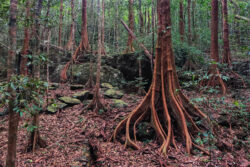The dry ground crumbled beneath my feet as I took slow and deliberate steps. The heat was making me sweat in profusion while I treaded carefully along tortuous dirt roads. With great tenacity, I scanned the ground for evidence of animal signs, anticipating a pile of fresh dhole feces and pugmarks. These walks constituted nearly seven hours a day, everyday, for 108 days of my life. Walking in the heart of Bandipur defined perseverance like nothing else.
I got the unique opportunity to study Asiatic wild dogs or dholes as a part of my graduate dissertation work. I walked the length and breadth of Bandipur Tiger Reserve in Karnataka, looking for dholes. As an aspiring carnivore biologist in 2012, the first lesson I was taught was to find, identify and appreciate telltale signs of predator presence. I was quick to learn that sketching in my field notebook was an excellent way to train myself in animal sign identifications. My incessant doodling habits proved more than useful during my fieldwork in Bandipur.
Here are some excerpts from my field notes.
 Animal tracks
Animal tracks

Day 27: My first sighting of dholes while on foot happened nearly a month after I had begun my fieldwork. This dhole ‘couple’ came on to the path after we had just walked by. They indulged in elaborate nudging. After about six minutes, they ran off along the fire line – as long as my eyes could see them.

Day 41: We were walking on a path lined with large trees, along the border of Bandipur and Wayanad. In a clearing, these two boulder-like beasts, huge male Gaurs, were grazing away to glory – the tall green grass, these wild cattle and the flock of Myna birds that fluttered around them

Day 46: It was a cold February morning. A cacophony of langur alarm calls surrounded the camp. It was a medium sized chital doe that the Rampura pack – 8 dholes in all – was pursuing. They did so many things, each one of them, it was hard to keep track. The dholes’ blood-smeared muzzles, the snarls, yip-yapping sounds and the occasional spats, were all just a few meters away from us. The doe was finished, all of her, in less than fifteen minutes.


Day 66: With all the langur and chital alarm calls, I was convinced it was a tiger lurking around in the thickets. While we drove, and it was getting dark, I didn’t expect to see the carnivore either. But as soon as we crossed the camp junction and entered the road, this leopard hopped out, ran along the path for a bit and jumped into the bushes on the other side. Then, it just sat there, in perfect camouflage.

Day 73: I don’t know what went wrong. I counted three of them. The two little ones continuously made squeaky noises. The mother was whacking Heteropogon grass with her trunk before she noticed our presence. All three trumpeted and started running away in utter chaos. She stopped, looked at us once and charged at us. The expression she gave during the brief pause was priceless.

Day 87: First I thought it was a Makhna. It wasn’t. She went near the young tusker very purposefully. Then they got into this strange mock fight. He managed to push her backwards – quite close to where we were standing. They then peacefully began foraging, as if nothing had happened.

Day 96: The sambar continued to bellow in the distance. The three of us stood in a single file along that path. My assistants whispered loudly from behind, “Sir.. Huli … Huli…!” I had no clue from where it would come out. I stood a little ahead of them. Then, from behind the trees, he came out. He looked at us once and walked off along the path. My hands trembled with excitement.

Day 96: My hands were still trembling. I had never expected such a close encounter with a tiger. The noise on my right side failed to grab my attention. When I turned around to smile at them, their faces suddenly paled. “Sir… Karadi!” the boys whispered. That’s when I turned to see this black fur ball coming out, thirty feet away.

Day 108: Home is where the heart is. My humble abode for a splendid 108 days – Rampura camp, where I left a piece of my heart.
Although it all started with compulsive renditions of animal signs, I soon discovered that sketching on field was far more gratifying and less cumbersome than relying on a camera to capture moments in the wild. I spent many a blissful evening sitting under a large tree, inking the best sightings of the day. Coupled with notes and descriptions in my personal diary, I managed to immortalize my Bandipur memories in a palm-sized notebook.





Instagram
junglelodgesjlr